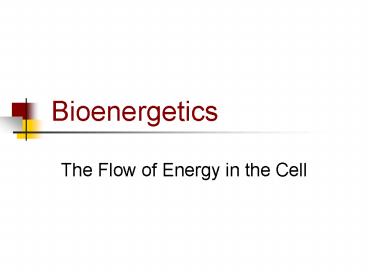Bioenergetics - PowerPoint PPT Presentation
1 / 25
Title:
Bioenergetics
Description:
Is there a great divide between the living and the nonliving? ... Energy from complex molecules simple molecules used to maintain order. ... – PowerPoint PPT presentation
Number of Views:167
Avg rating:3.0/5.0
Title: Bioenergetics
1
Bioenergetics
- The Flow of Energy in the Cell
2
Living Versus Nonliving
- Living cells/organisms maintain order.
3
Life Has 4 Essential
Requirements
- Molecules that provide basic building blocks
- Chemical catalysts (enzymes)
- Information that guide activities
- Energy to drive reactions and processes
necessary for life
4
Nonliving Versus Living
5
Maintenance of Order
- How do cells maintain or create order?
Energy
6
Energy
- Capacity to cause change capacity to do work
the ability to rearrange matter. - Kinetic energy of motion
- Examples
- Heat (random movement of molecules)
- Light (movement of photons)
- Potential stored energy or energy of position
- Example
- Chemical energy (energy due to structure)
7
Flow of Energy through Biosphere
Against concentration, electrical gradient
http//cwx.prenhall.com/bookbind/pubbooks/mcmurryg
ob/medialib/media_portfolio/text_images/FG21_01.JP
G
8
(No Transcript)
9
Ultimate Fate of All Energy.
- Is to become randomized in the biosphere as
increased entropy. - Energy flows from nuclear fusion of sun to
eventual sink, the entropy of the universe. - Every process of reaction that occurs in the
universe leads to greater entropy.
10
Energetics
- Is there a great divide between the living and
the nonliving? - No, according to Erwin Schrödinger
- Both obey same laws of chemistry physics
- Thermodynamics laws and principles that govern
flow of energy.
11
Closed System
System Surroundings Universe
surroundings
system
http//www.lovebird.ca/assets/images/vt032s.jpg
12
Open System
- Energy is transferred to or from the surroundings.
http//www.teamworknet.com/resourcelibrary/ presen
tations/CatsDogs/images/cats.jpg
http//www.ir55.com/images/thermal20infrared20se
nsitivity20imagery.jpg
13
1st Law of Thermodynamics
The law of conservation of energy
- Energy can be transferred or transformed but
cannot be created or destroyed.
14
1st Law of Thermodynamics
- During any reaction the total amount of E that
leaves the system the E that enters the system
minus E that is stored within system - ?E difference in internal energy of the system
before the reaction (E1) and after the reaction
(E2)
15
Meaning of ?E
- ?E E2 E1
- ?E E products E reactants
- Change in enthalpy (heat content)
- H E PV
- ?H ?E ?(PV) PV 0
- ?H H products H reactants
- ?H Neg (endothermic), Positive (exothermic)
16
2nd Law of Thermodynamics
- Every energy transfer or transformation increases
entropy of the universe.
17
Does life violate 2nd law?
- NO!
- Life forms are open systems.
- Energy from complex molecules ? simple molecules
used to maintain order. - Heat generated ? entropy of surroundings.
18
(No Transcript)
19
DG (Change in Free Energy)
- DG is convenient way to measure the amount of
disorder created in the universe when a chemical
reaction takes place.
20
Energy Profiles
DG Gproducts - Greactants
Exergonic Reaction (Spontaneous)
Endergonic Reaction (Non-spontaneous)
transition state
transition state
Free energy ?
EA
EA
products
DG gt 0
reactants
DG lt 0
products
reactants
Progress of reaction ?
21
What if DG 0?
- Reaction has reached chemical equilibrium.
22
Relationship Between Keq DG
(DG 0)
Keq
23
DG
- Free energy change under standard conditions
- indicates pH 7.0
- indicates
- products reactants 1.0M (except water)
- Temperature 25C 298K
- Pressure 1 atmosphere
- Useful way to compare reactions.
24
DG
- Under standards conditions, all of these
reactions will proceed to right.
25
Relating DG to DG
R 1.987 cal/molK T temperature in Kelvin































